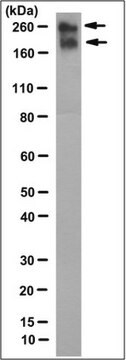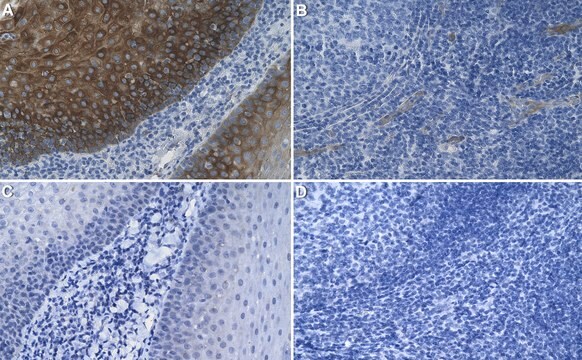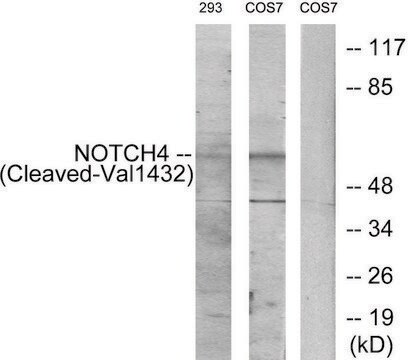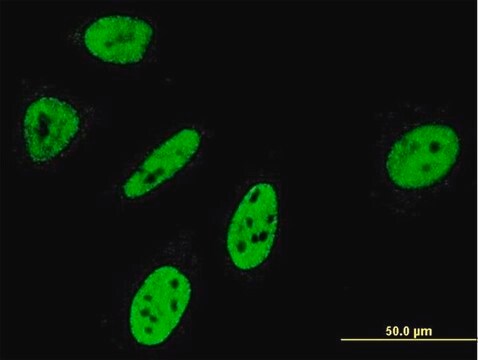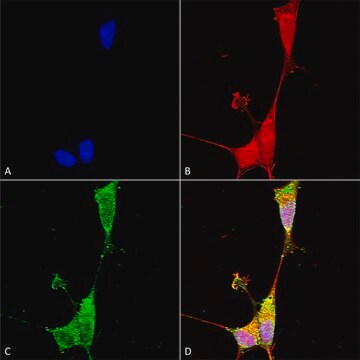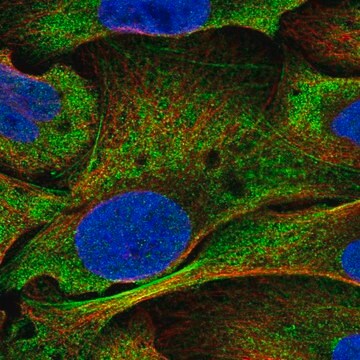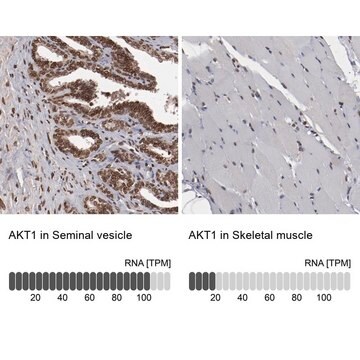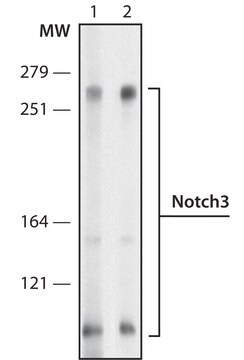推荐产品
一般說明
Neurogenic locus notch homolog protein 3 (UniProt Q9UM47; also known as Notch 3, Notch homolog 3) is encoded by the NOTCH3 (also known as CASIL, CADASIL, IMF2) gene (Gene ID 4854) in human. Notch 3 is a transmembrane receptor required for arterial differentiation and maturation of vascular smooth muscle cells in small arteries. Notch 3 is initially produced with a signal peptide (a.a. 1-39), the removal of which yields the 2282-amino acid Notch 3 (a.a. 40-2321), which undergoes a constitutive proteolytical cleavage, generating the extracellular fragment (Notch3-ECD; a.a. 40-1628) and the transmembrane/cytosolic (Notch3-TMIC; a.a. 1629-2321) fragment that remain associated at the cell surface to form a heterodimeric receptor. The ECD fragment contains all 34 EGF-like domains and the three Lin/Notch (LNR) repeats, while the extracellular portion of TMIC contains 5 ankyrin repeats. Mutations in the NOTCH3 gene have been identified as the underlying cause of cerebral autosomal dominant arteriopathy with subcortical infarcts and leukoencephalopathy (CADASIL). Pathogenic mutations predominantly affect cysteine residues within EGF-like repeats of Notch3-ECD, leading to Notch3-ECD multimerization and accumulation in the tunica media of vessel walls.
特異性
Clone 2G8 reacts with unprocessed Notch 3 and the extracellular (Notch 3-ECD; a.a. 40-1628) fragment, but not the transmembrane/cytosolic fragment (Notch 3-TMIC, also called Notch 3 extracellular truncation; a.a. 1629-2321) or the Notch 3 intracellular fragment (a.a. 1662-2321).
免疫原
Epitope: Extracellular EGF-like domains 33-34.
KLH-conjugated linear peptide corresponding to a sequence from the EGF-like domains 33-34 region of human Notch 3 ECD.
應用
Anti-Notch 3 Antibody, ECD, clone 2G8 is an antibody against Notch 3 for use in Immunohistochemistry (Paraffin), Immunofluorescence, Western Blotting.
Immunohistochemistry Analysis: 20 µg/mL of this antibody from a representative lot detected Notch 3 extracellular domain (ECD) deposits in blood vessels of CADASIL patients brain tissue sections (Courtesy of Institute for Stroke and Dementia Research, Clinical center of the Ludwig-Maximilians University Munich, Germany).
Immunohistochemistry Analysis: A representative lot detected the aggregated Notch 3 extracellular domain (ECD) deposits in brain blood vessels of CADASIL patients by immunohistochemistry staining of paraformaldehyde-fixed, paraffin-embedded brain tissue sections (Kast, J., et al. (2014). Acta Neuropathol. Commun. 2:96).
Immunofluorescence Analysis: A representative lot detected the aggregated Notch 3 extracellular domain (ECD) deposits in brain blood vessels of CADASIL patients by fluorescent immunohistochemistry staining of paraformaldehyde-fixed frozen brain tissue sections. The Notch3-EDC immunoreactivity was seen co-localized with that of LTBP-1, but not fibrillin-1 (Kast, J., et al. (2014). Acta Neuropathol. Commun. 2:96).
Western Blotting Analysis: A representative lot detected an elevated accumulation of aggregated Notch 3 extracellular domain (ECD) in brain blood vessel extracts from CADASIL patients when comparing to vessel extracts from non-diseased brains (Kast, J., et al. (2014). Acta Neuropathol. Commun. 2:96).
Immunohistochemistry Analysis: A representative lot detected the aggregated Notch 3 extracellular domain (ECD) deposits in brain blood vessels of CADASIL patients by immunohistochemistry staining of paraformaldehyde-fixed, paraffin-embedded brain tissue sections (Kast, J., et al. (2014). Acta Neuropathol. Commun. 2:96).
Immunofluorescence Analysis: A representative lot detected the aggregated Notch 3 extracellular domain (ECD) deposits in brain blood vessels of CADASIL patients by fluorescent immunohistochemistry staining of paraformaldehyde-fixed frozen brain tissue sections. The Notch3-EDC immunoreactivity was seen co-localized with that of LTBP-1, but not fibrillin-1 (Kast, J., et al. (2014). Acta Neuropathol. Commun. 2:96).
Western Blotting Analysis: A representative lot detected an elevated accumulation of aggregated Notch 3 extracellular domain (ECD) in brain blood vessel extracts from CADASIL patients when comparing to vessel extracts from non-diseased brains (Kast, J., et al. (2014). Acta Neuropathol. Commun. 2:96).
Research Category
Inflammation & Immunology
Inflammation & Immunology
Research Sub Category
Nervous System
Nervous System
品質
Identity Confirmation by Isotyping Test.
Isotyping Analysis: The identity of this monoclonal antibody is confirmed by isotyping test to be IgG2aκ.
Isotyping Analysis: The identity of this monoclonal antibody is confirmed by isotyping test to be IgG2aκ.
標靶描述
243.6 kDa (Pre-form), 239.5 kDa (mature, unprocessed), 167.13 kDa (Notch 3-ECD) calculated. ~250 kDa (Notch 3-ECD) reported (Kast, J., et al. (2014). Acta Neuropathol. Commun. 2:96).
外觀
Protein G Purified
Format: Purified
Purified rat monoclonal IgG2aκ antibody in buffer containing 0.1 M Tris-Glycine (pH 7.4), 150 mM NaCl with 0.05% sodium azide.
儲存和穩定性
Stable for 1 year at 2-8°C from date of receipt.
其他說明
Concentration: Please refer to lot specific datasheet.
免責聲明
Unless otherwise stated in our catalog or other company documentation accompanying the product(s), our products are intended for research use only and are not to be used for any other purpose, which includes but is not limited to, unauthorized commercial uses, in vitro diagnostic uses, ex vivo or in vivo therapeutic uses or any type of consumption or application to humans or animals.
未找到合适的产品?
试试我们的产品选型工具.
儲存類別代碼
12 - Non Combustible Liquids
水污染物質分類(WGK)
WGK 1
閃點(°F)
Not applicable
閃點(°C)
Not applicable
我们的科学家团队拥有各种研究领域经验,包括生命科学、材料科学、化学合成、色谱、分析及许多其他领域.
联系技术服务部门